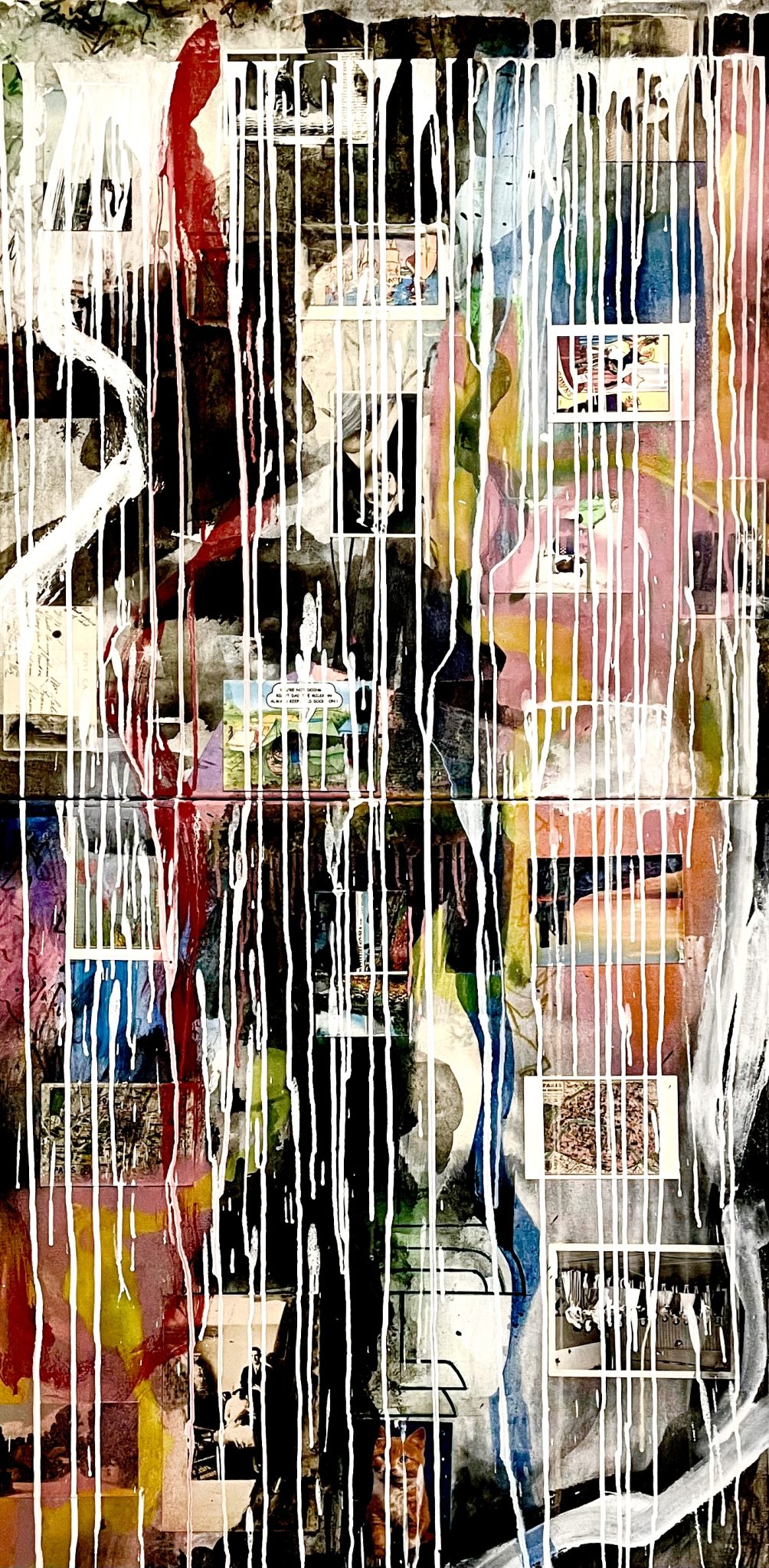2019 saw the initial push for Robert Bradford’s Trash Art Series. A wave of personal change ushered in a period of domestic and creative self-reflection, as it does. In Bradford’s case this began by literally tearing up previous works, mostly figurative, mostly on paper, and reconfiguring them into semi-abstracted compositions, helpfully entitled ‘Cuttups’. Each major life-change requires a corresponding discharge of old methods, means and habits as catharsis clears the way for individual innovation. The Trash Art Series then, can be viewed as a positive transitional manifestation of creative action that carries with it the unique dynamism of flux… or perhaps even Fluxus!
The famous art movement of the 1960’s onwards prioritised process over final product, and treated open-ended art action as key. Bradford is not a Fluxus artist but the spirit of ‘anti-art’ remains alongside a pinch neo-Dadaism. Each destructive tendency relies on its opposite constructive force. The word ‘trash’ in this context reveals a self-aware burst of nihilistic energy, a wanton expulsion of the old guard which doubles as a catalytic force. Hence the vigour of transition drives the Trash Art Series and lays the ground for what comes next.
Zoom into the paintings and drawings of ‘Trash Art’ and we see evidence of these tectonic shifts in detail. As Bradford began to move away from figuration recognisable elements were turned upside down, torn through and reconfigured to deliberately obscure their representational meaning. Bitter visual allegory begins to give way to uncertainty, and the harsh juxtaposition of confusion is harnessed in ripped edges, conflicting styles and abrupt colour contrasts.

What the resulting pictures record is a process of flux that evolves into the equivalent of a photo dump, and the subsequent stratification of a personal recent history. Soon the fragmented surfaces of the Trash Art Series begin to settle as the past is buried and subsumed into the miasma of memory. Circa 2021, Bradford explains,
‘…responding directly to the underlying forms, spaces, and colours of the figurative works helped to trigger new, more abstract ideas. The layering of sections in the Cuttup drawings added a further stimulus, structure, visual depth, and a valued “history” to the overall process.’
So, we can say, if flux is grist to the mill of history, then history is the bread on which the future feeds! Trash, in the best sense of the word, begins a process of decomposition which becomes the soil of new growth. The thrash, slash, and sheer visual noise of these works is energizing, riotous, and purposefully jarring. Yet retained amidst all the chaotic cuts, sharp hues and jagged lines is an unmistakable balance of calculated aesthetic measure. The buzz of friction is tempered by the balm of a restorative artistic eye, as if the very action of destruction paradoxically triggers it’s healing repair.
Painting as an activity requires a lot of physical effort, and at its best demands the sportsman-like pairing of freedom with focus. The combined works of the Trash Art Series tells an engaging, exotic and energetic story of pain, productivity, change and reconciliation in a very enjoyable and relatable way.
The famous art movement of the 1960’s onwards prioritised process over final product, and treated open-ended art action as key. Bradford is not a Fluxus artist but the spirit of ‘anti-art’ remains alongside a pinch neo-Dadaism. Each destructive tendency relies on its opposite constructive force. The word ‘trash’ in this context reveals a self-aware burst of nihilistic energy, a wanton expulsion of the old guard which doubles as a catalytic force. Hence the vigour of transition drives the Trash Art Series and lays the ground for what comes next.
Zoom into the paintings and drawings of ‘Trash Art’ and we see evidence of these tectonic shifts in detail. As Bradford began to move away from figuration recognisable elements were turned upside down, torn through and reconfigured to deliberately obscure their representational meaning. Bitter visual allegory begins to give way to uncertainty, and the harsh juxtaposition of confusion is harnessed in ripped edges, conflicting styles and abrupt colour contrasts.
